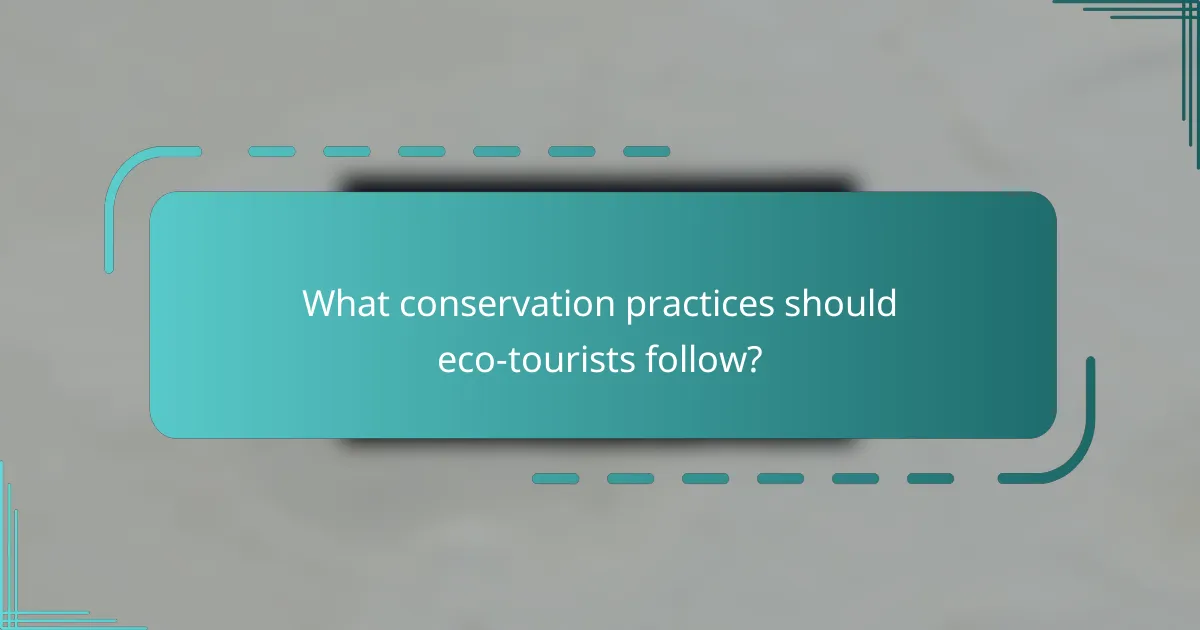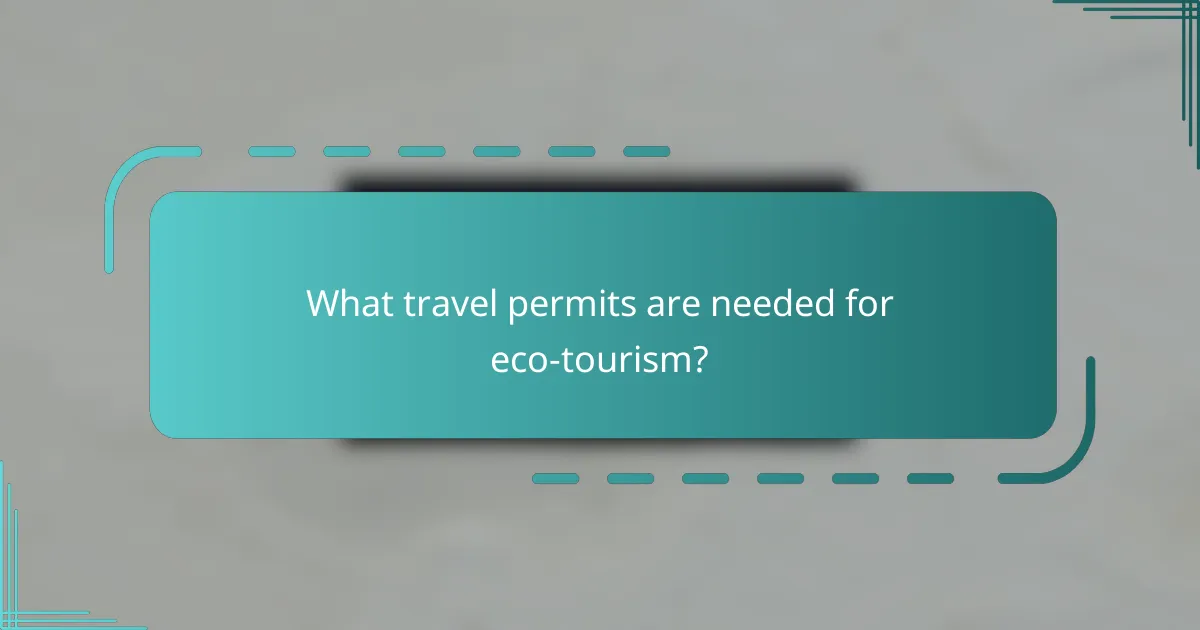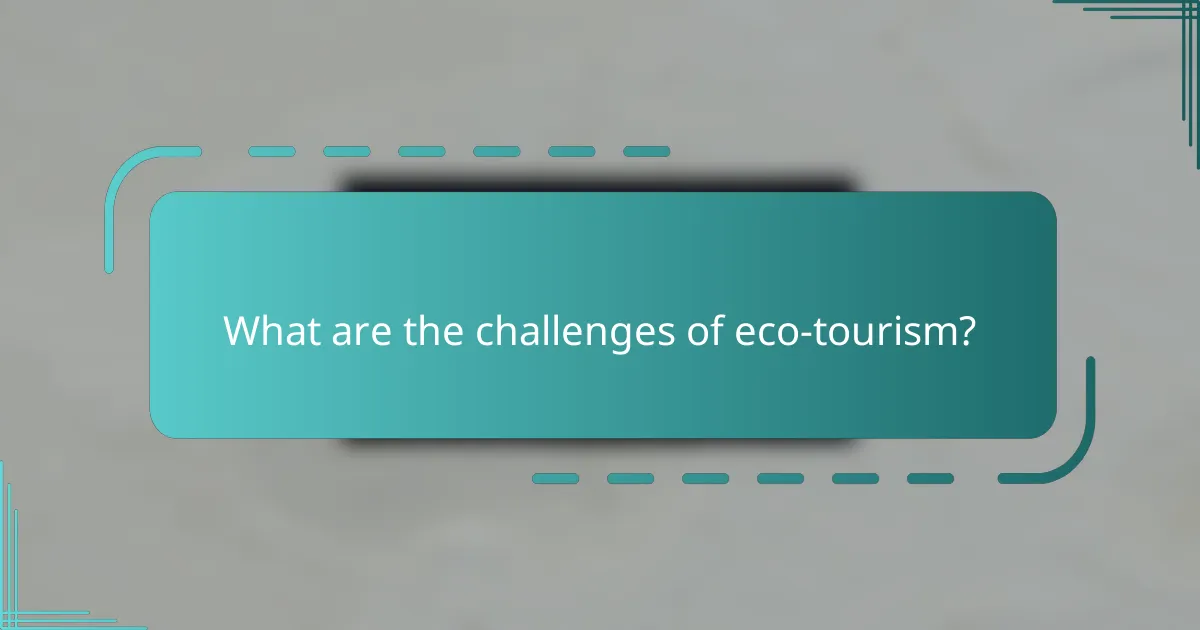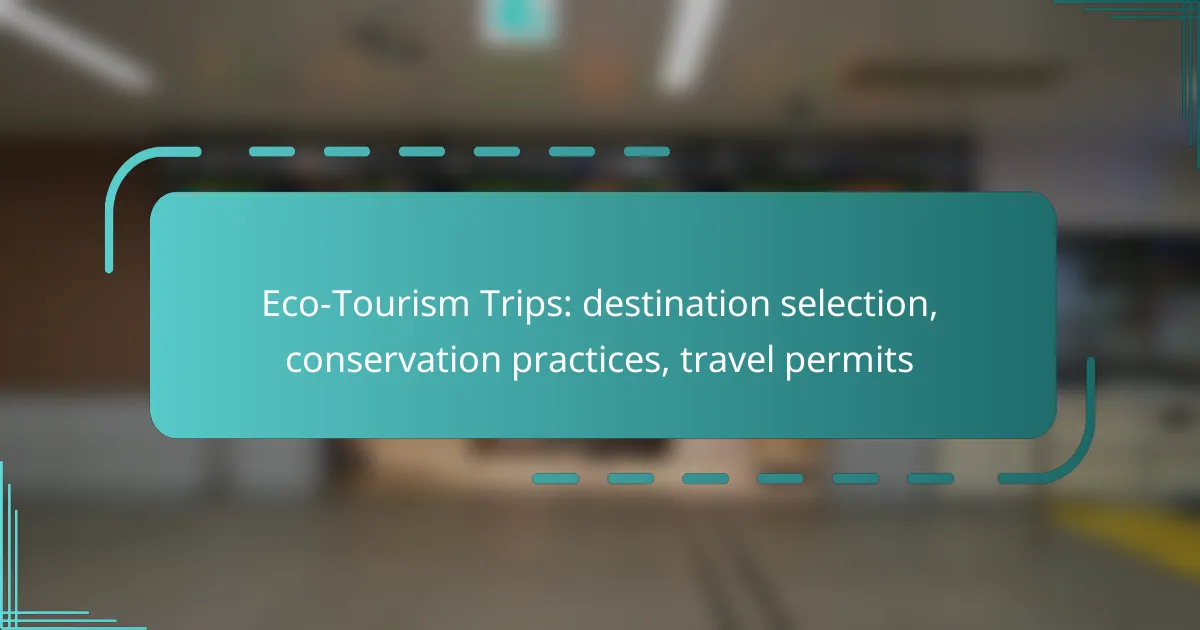Eco-tourism trips offer travelers the chance to explore breathtaking natural landscapes while promoting sustainability and conservation. By selecting destinations that prioritize environmental protection, such as Costa Rica or the Galapagos Islands, travelers can engage in meaningful experiences that benefit local ecosystems and communities. It’s essential to choose operators committed to sustainable practices and to actively participate in conservation efforts during your journey.

What are the best eco-tourism destinations in the Americas?
The Americas offer a variety of eco-tourism destinations that prioritize sustainability and conservation. Notable locations include Costa Rica, the Galapagos Islands, and the Amazon rainforest, each providing unique experiences that support environmental protection while allowing travelers to connect with nature.
Costa Rica eco-lodges
Costa Rica is renowned for its eco-lodges that blend comfort with environmental responsibility. These accommodations often utilize renewable energy sources, practice water conservation, and promote local biodiversity. Guests can choose from a range of options, from luxury lodges to rustic cabins, all designed to minimize their ecological footprint.
When selecting an eco-lodge, consider its certifications, such as the Certification for Sustainable Tourism (CST). Look for lodges that offer guided nature tours, wildlife observation, and community engagement activities to enhance your eco-friendly experience.
Galapagos Islands conservation tours
The Galapagos Islands are a prime destination for conservation-focused tours that educate visitors about the unique ecosystems and species. Tour operators often collaborate with local conservation organizations to ensure that tourism supports wildlife protection efforts. These tours typically include guided hikes, snorkeling, and opportunities to observe endemic species in their natural habitats.
Travelers should be aware of the strict regulations in place to protect the islands. Permits are required for most activities, and group sizes are limited to minimize environmental impact. Booking with certified operators ensures compliance with these regulations and contributes to conservation funding.
Amazon rainforest experiences
The Amazon rainforest offers immersive experiences that highlight the importance of conservation in one of the world’s most biodiverse regions. Eco-tours often include guided treks, canoeing, and visits to indigenous communities, providing insights into sustainable living practices. Travelers can engage in activities like birdwatching and wildlife spotting, all while supporting local economies.
Before embarking on an Amazon adventure, research tour operators that prioritize sustainability and community involvement. Look for tours that include educational components about the rainforest’s ecology and the challenges it faces, ensuring a responsible and enriching travel experience.

How to choose an eco-tourism trip?
Choosing an eco-tourism trip involves selecting destinations that prioritize environmental conservation and community well-being. Look for operators that emphasize sustainable practices and contribute positively to local ecosystems and economies.
Assessing sustainability practices
When evaluating sustainability practices, consider the eco-tourism operator’s commitment to minimizing environmental impact. This includes their waste management strategies, use of renewable energy, and conservation efforts. Operators should ideally adhere to recognized standards such as the Global Sustainable Tourism Council (GSTC) criteria.
Check if the trip includes activities that promote conservation, such as wildlife monitoring or habitat restoration. A good practice is to look for tours that are certified by reputable organizations, ensuring they meet specific sustainability benchmarks.
Evaluating local community impact
Assessing local community impact involves understanding how your trip benefits the residents and culture of the area. Choose operators that engage local communities in tourism activities, providing them with economic opportunities and preserving their cultural heritage. This can include employing local guides or sourcing food and materials from local suppliers.
Additionally, look for tours that support community projects, such as education or healthcare initiatives. Engaging with local communities not only enriches your travel experience but also ensures that tourism contributes positively to their livelihoods.

What conservation practices should eco-tourists follow?
Eco-tourists should prioritize sustainable practices that protect natural habitats and wildlife. Key conservation practices include adhering to leave no trace principles and actively supporting local conservation efforts.
Leave no trace principles
Leave no trace principles are guidelines designed to minimize human impact on the environment. These principles encourage eco-tourists to plan ahead, travel on durable surfaces, and dispose of waste properly.
Practicing these principles means avoiding the collection of natural items, such as plants or rocks, and respecting wildlife by observing from a distance. For example, when hiking, stick to marked trails to prevent soil erosion and protect native vegetation.
Supporting local conservation efforts
Supporting local conservation efforts is crucial for sustaining the ecosystems that attract eco-tourists. This can involve donating to local wildlife organizations, participating in community clean-up events, or choosing eco-friendly accommodations that contribute to conservation initiatives.
Engaging with local communities can also enhance your travel experience. For instance, consider visiting eco-tourism projects that promote wildlife protection and habitat restoration, which often provide educational opportunities about the local environment and culture.

What travel permits are needed for eco-tourism?
Travel permits for eco-tourism often include national park entry permits and wildlife photography permits. These permits ensure that visitors comply with local regulations and contribute to conservation efforts.
National park entry permits
National park entry permits are typically required to access protected areas. These permits help manage visitor numbers and fund conservation initiatives. Fees can vary widely, often ranging from a few dollars to several tens of dollars, depending on the park and country.
To obtain a national park entry permit, check the specific park’s website or contact local authorities. Some parks offer online applications, while others may require in-person purchases at park entrances. Always verify if there are additional fees for guided tours or special activities.
Wildlife photography permits
Wildlife photography permits are necessary in many regions to protect sensitive ecosystems and wildlife. These permits may be required for both professional and amateur photographers, ensuring that photography activities do not disturb animals or their habitats.
When applying for a wildlife photography permit, consider the specific regulations of the area you plan to visit. Fees can vary, and some locations may have restrictions on equipment or the number of photographers allowed at a time. Always respect wildlife and follow ethical photography practices to minimize your impact on the environment.

How does eco-tourism benefit local communities?
Eco-tourism provides significant advantages to local communities by promoting sustainable practices that protect the environment while generating economic opportunities. This form of tourism encourages visitors to engage with local cultures and ecosystems, leading to both financial and social benefits for residents.
Job creation in conservation
Eco-tourism creates jobs focused on conservation efforts, such as wildlife management, park maintenance, and environmental education. These roles not only offer employment but also foster a sense of stewardship among locals, encouraging them to protect their natural resources.
For example, a community-based eco-tourism project may hire guides to lead nature tours, providing them with a stable income while raising awareness about local biodiversity. This can lead to a more sustainable economy, where the community invests in preserving its environment for future generations.
Support for local artisans
Eco-tourism often includes opportunities for local artisans to showcase and sell their crafts, which can significantly boost their income. Tourists are typically interested in purchasing authentic, handmade products, which helps preserve traditional skills and cultural heritage.
For instance, markets or shops that feature local crafts can thrive in eco-tourism hotspots, allowing artisans to reach a wider audience. This not only provides financial support but also enhances the cultural experience for visitors, creating a mutually beneficial relationship.

What are the challenges of eco-tourism?
Eco-tourism faces several challenges, primarily related to environmental sustainability and community impact. Key issues include overtourism in sensitive areas and the need to balance profit with conservation efforts.
Overtourism in sensitive areas
Overtourism occurs when the number of visitors exceeds the capacity of a destination, leading to environmental degradation and loss of biodiversity. Sensitive areas, such as national parks or wildlife reserves, are particularly vulnerable, as increased foot traffic can damage ecosystems and disrupt local wildlife.
To mitigate overtourism, destinations can implement visitor limits, require advance booking, or establish designated trails. For example, some parks in the United States have introduced timed entry systems to control the flow of visitors and protect natural resources.
Balancing profit and conservation
Balancing profit and conservation is crucial for the sustainability of eco-tourism. While tourism can provide significant economic benefits to local communities, it can also lead to practices that harm the environment if not managed carefully.
Operators should focus on sustainable practices, such as using local materials, supporting conservation initiatives, and educating tourists about environmental impacts. For instance, eco-lodges that invest a portion of their profits into local conservation projects can create a win-win situation for both the economy and the environment.

What are emerging trends in eco-tourism?
Emerging trends in eco-tourism focus on sustainable practices that benefit both the environment and local communities. These trends include innovative travel options and practices aimed at enhancing conservation efforts while providing unique experiences for travelers.
Virtual eco-tours
Virtual eco-tours are an increasingly popular way to experience nature and wildlife without the carbon footprint associated with travel. These online experiences often feature live-streamed tours, interactive sessions with guides, and immersive 360-degree videos that allow participants to explore remote locations from home.
Travelers can engage with local cultures and ecosystems through virtual platforms, making it accessible for those unable to travel physically. This trend not only promotes awareness of conservation issues but also supports local economies by providing an alternative revenue stream.
Regenerative travel practices
Regenerative travel practices go beyond sustainability by actively improving the environments and communities visited. This approach emphasizes leaving a place better than it was found, often through initiatives like reforestation, wildlife rehabilitation, and community development projects.
Travelers can participate in hands-on activities such as planting trees or volunteering with local conservation groups. By choosing accommodations and tour operators that prioritize regenerative practices, eco-tourists can contribute to long-term ecological health and community resilience.
